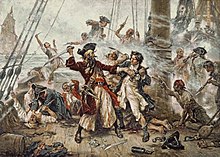
Back العصر الذهبي للقراصنة Arabic Златен век на пиратството Bulgarian Edat d'or de la pirateria Catalan Goldenes Zeitalter (Piraterie) German Χρυσή εποχή της πειρατείας Greek Edad de oro de la piratería Spanish Piraatluse kuldajastu Estonian دوران طلایی دزدی دریایی Persian Âge d'or de la piraterie French Ré Órga na bhFoghlaithe Mara Irish
| Golden Age of Piracy | |
|---|---|
| 1650s–1730s | |
 | |
| Location |
|
The Golden Age of Piracy is a common designation for the period between the 1650s and the 1730s, when maritime piracy was a significant factor in the histories of the North Atlantic and Indian Oceans.
Histories of piracy often subdivide the Golden Age of Piracy into three periods:
- The buccaneering period (approximately 1650 to 1680), characterized by Anglo-French seamen based in Jamaica and Tortuga attacking Spanish colonies, and shipping in the Caribbean and eastern Pacific to western Pacific.
- The Pirate Round (1690s), associated with long-distance voyages from the Americas to rob Muslim and East India Company targets in the Indian Ocean and Red Sea.
- The post-Spanish Succession period (1715 to 1726), when Anglo-American sailors and privateers left unemployed by the end of the War of the Spanish Succession turned en masse to piracy in the Caribbean, the Indian Ocean, the North American eastern seaboard, and the West African coast.
Narrower definitions of the Golden Age sometimes exclude the first or second periods, but most include at least some portion of the third. The modern conception of pirates as depicted in popular culture is derived largely, although not always accurately, from the Golden Age of Piracy.
Factors contributing to piracy during the Golden Age included the rise in quantities of valuable cargoes being shipped to Europe over vast ocean areas, reduced European navies in certain regions, the training and experience that many sailors had gained in European navies (particularly the British Royal Navy), and corrupt and ineffective government in European overseas colonies. Colonial powers at the time constantly fought with pirates and engaged in several notable battles and other related events.
© MMXXIII Rich X Search. We shall prevail. All rights reserved. Rich X Search